
11 minute read
UGANDA
Truly the Pearl ofAfrica
Spanning the equator with an irresistibly beautiful landscape of sun-dappled savannah, tangled forests and great lakes, Uganda is famous as one of Africa’s greatest safari destinations. Mark Eveleigh crosses the equator (several times) to experience the great diversity of ‘The Pearl of Africa’. Words by Mark Eveleigh
Advertisement

Sitting at a cafe six kilometres south of Entebbe, I am fleetingly wondering whether it will be more effective to stir my strong Ugandan coffee in a clockwise or counterclockwise direction.
I realise that I’m pondering the same sort of senseless questions that a visit to the equator provokes no matter where you are. The equator bisects the landmasses of eleven countries (seven African), and Uganda’s equator monument abounds with the same pseudo-scientific experiments that I’ve seen at several others in South America and Asia.
“We’ve got basins set up so that you can see how the water drains in opposite directions depending on where you stand,” says a young man who’s beckoning me from beside the whitewashed arch that’s marked ‘N’ and ‘S’.
While the phenomenon, known as the Coriolis Effect, is very real, scientists claim that it is weakest at the equator and that the experiment appears to function merely because of the shape or tilt of the basins. There is another myth that it’s possible to balance an egg on a nail as long as you are standing absolutely on the equator but, take my word for it, you can scramble a lot of eggs trying it no matter where you are on the planet.
Nevertheless, there’s a definite thrill in standing with one foot in each hemisphere and few visitors can resist a
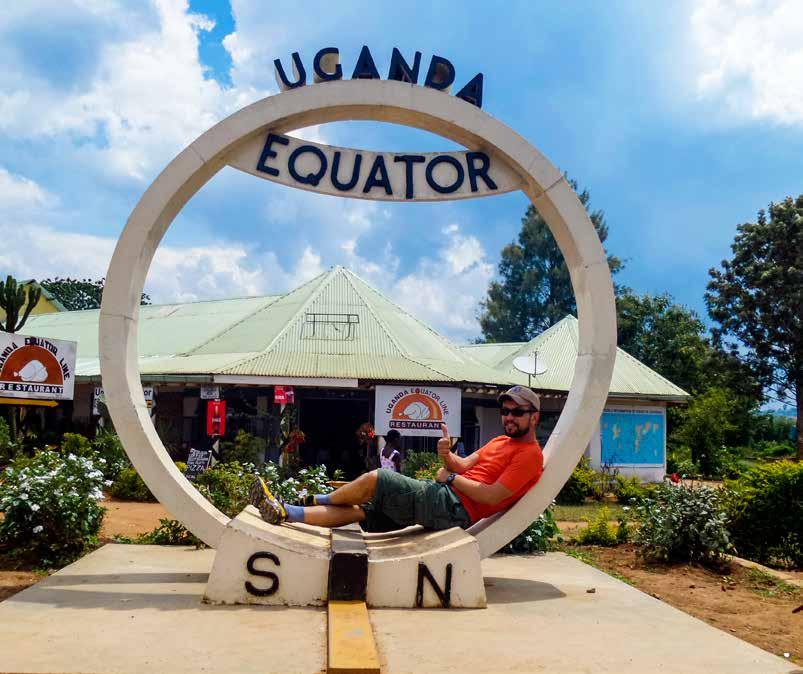
photo opportunity here. But then Uganda has more than its share of spectacular geographical claims-to-fame. If Entebbe often strikes first-time visitors to this landlocked African country as a ‘beach town’, it’s for a good reason; it’s built on a sort of peninsula in Lake Victoria, the world’s second-biggest lake (after Lake Superior).
Uganda is also home to the spot where the world’s longest river, the Great River Nile – father of African Rivers – begins its record-breaking 6,650km journey to the Mediterranean Sea.
For anyone with a fascination for geography, and let’s face it, the subject is an obsession of almost every keen traveller


– Uganda is hard to beat. Who can resist the spark of adventure that’s kindled by names like Bwindi Impenetrable Forest or the fabled ‘Mountains of the Moon’? In fact, these mountains, known today as Rwenzori Mountains National Park, inspired Greek geographers as far as 2000 years ago. The so-called impenetrable forest is surprisingly accessible and attracts large numbers of visitors to watch wild gorillas in their natural habitat – but even today the glacier-cloaked peaks of the Rwenzoris are accessible only to expeditions.
I first fell in love with the country that Winston Churchill called ‘The Pearl of Africa’ when I drove across the border from Rwanda at the start of a month-long safari through the country’s ten national parks. Feeling slightly intimidated by my first overland crossing from a left-handdrive country to a right-hand-drive one, I’d negotiated the Land Rover cautiously through the swarms of motorcycle taxis that are known all over Uganda as boda-boda (from the word ‘border’). When I parked an hour later at the foothills of the Virunga Volcanic Range, it was as if a welcoming committee had been organised: Uganda is one of Africa’s best bird-spotting locations, and it was the courtship season for crowned cranes (the country’s national bird). All over the plains, hundreds of these truly regal birds
Opposite page: The Uganda Equator Top, Left and Bottom: Beautiful shots of The Rwenzori Mountains Extreme Bottom: A silverback gorilla in Bwindi Impenetrable Forest

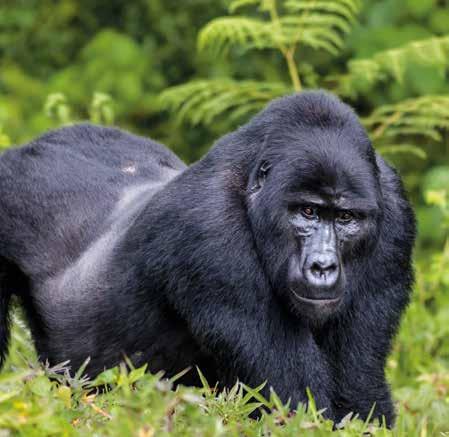

Ernest Hemmingway
could be seen strutting with their golden headdresses glittering in the sun.
At only 33.7 square kilometres, Mgahinga Gorilla National Park is Uganda’s smallest national park but it falls within the great Virunga Conservation Area, stretching also into Rwanda and Congo. An hour’s drive to the north, Bwindi is home to about 459 mountain gorillas, almost half the world’s population. At almost ten times the size of Mgahinga, Bwindi is very likely the best place in the world to see one of the world’s most iconic and endangered species.
“The more you learn about the dignity of the gorilla, the more you want to avoid people,” wrote Dian Fossey, the famous American researcher.
The more we began to travel through Uganda, however, the more I enjoyed contact with some of the friendliest and most hospitable people I’d met in Africa. Wherever we drove, it seemed that we had to keep one arm constantly out of the window ready to wave at passers-by. Traders waved at us in the villages, and on the highways, boda-boda riders tooted their horns. Frequently, we passed herds of majestic Ankole cattle with their impossibly soaring horns rising like spires above the clouds of laterite dust, and the herdsmen always yelled in greeting.
Eventually, we turned off the highway onto the wilderness trails of Queen Elizabeth II National Park where herds of a different sort awaited us. Queen Elizabeth, the flagship of Uganda’s savannah parks, is known for its vast numbers of buffalo and elephant as well as for its predators. Entering the park, we also found another equator monument – this one remoter and, for once, devoid of scientific blandishments.
I was spellbound by the vast expanses of rippling savannah, tanned the colour of a lion’s hide, that sloped down to the Kazinga Channel with its immense pods of hippos and then climbed upwards again to where the distant Rwenzori peaks were lost in the clouds. As a classic safari destination, Queen Elizabeth has it all; savannah, lakes and forests that are home to 95 species of mammals. These include ten primates, and the Kyambura Gorge area is one of the best places in the world to walk among wild chimpanzees.
Uganda’s ‘wild west’ is a spectacularly beautiful wilderness region dotted with forest, savannah and a chain of serene lakes that make you want to spend enough time to get to know them on first-name basis: Edward, George and Albert.
At Murchison Falls National Park, the feeling of tranquility explodes as the full might of the Nile River injects itself at a rate of about 300 cubic metres per second through an eight-metre-wide chasm to explode into the ominously named Devil’s Cauldron. This is the




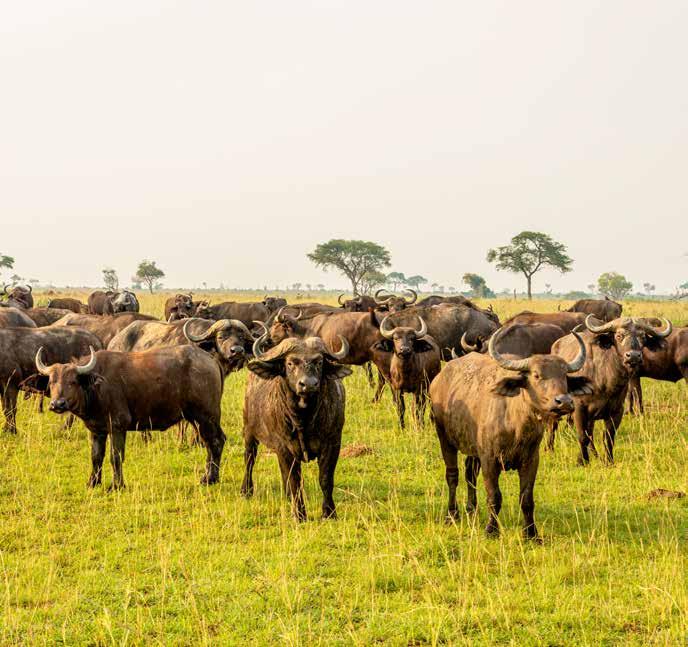
Opposite page:
Motorcycle taxis, known all over Uganda as boda-bodas, are a commonly preferred quick means of transport.
Anti-clockwise from left: A herd of elephants cools off in the Ishasha River, as a pod of hippos takes a swim in the Kazinga Channel, both in Queen Elizabeth National Park. However, the buffalo herds here are dwarfed by the vast numbers along Kidepo’s Narus Valley. Crested cranes are a sight to behold as they dance and flirt during their mating season.
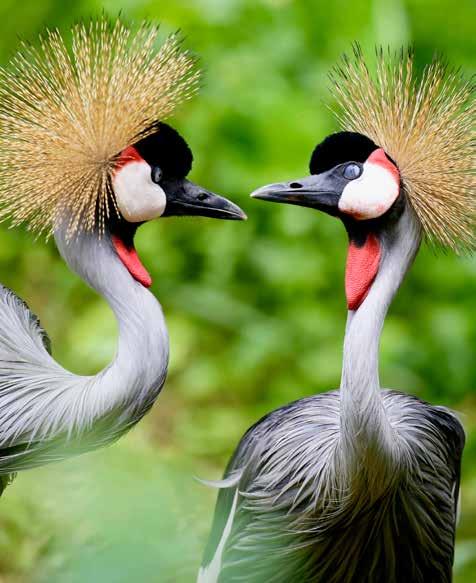
most spectacular waterfall in East Africa and as you stand at the top of the falls, you can feel the thunderous power vibrating up through the rock like an earthquake.
‘I never knew of a morning in Africa when I woke up that I was not happy,’ wrote Ernest Hemmingway, who had some notoriously dramatic adventures in this area in the 1950s. Waking up at Apoka Lodge, in the gorgeous Kidepo National Park, I could share the great writer’s sentiments. I’d woken in the early hours of the morning to listen to the guttural roar of a lion, seemingly right outside my chalet. Sure enough, I’d walked cautiously outside in the morning to find a huge pugmark imprinted deep into the sand within a few metres of my door.
One of the marks of a perfectly designed lodge or camp is how not only humans, but also wildlife interact with it. Apoka Lodge is appreciated as much by the natural inhabitants of Kidepo as it is by visitors. While I ate breakfast, I watched zebra and hartebeest at the waterhole and a pair of waterbuck sipping from the swimming pool, and the staff told me that lions regularly used the lodge buildings for shady vantage points over the plains.
The words of another Africa writer came to mind: ‘You know you are truly alive when you’re living among lions’, Karen Blixen wrote in her book, Out of Africa. This was not my first visit to Kidepo, and the park had been the setting for all my most dramatic lion encounters. I had been camping here in Land Rovers, with a couple of South African friends several years earlier, when I looked up from atop the landrover to see no less than seven lionesses lying along the top of a long boulder. They were contemplating me with the sort of lazy curiosity that made me realise they had probably been doing so for quite some time, but were too satisfied by the numerous prey to eat me.
There are an estimated 120 lions in Kidepo, and they are known for the power and tactical skill that is an adaptation to hunting the vast herds of buffalo that roam here. Even the buffalo herds of Queen Elizabeth National Park were dwarfed by the vast numbers along Kidepo’s Narus Valley when ranger Philip Akorongimoe and I drove out to explore that morning. A group of aged askari bulls – ‘Old Generals’, as Phillip called them – watched us with resentful eyes and horns lowered as a vast herd of females and calves speckled the scrub behind them. There seemed to be buffalo in mind-boggling numbers
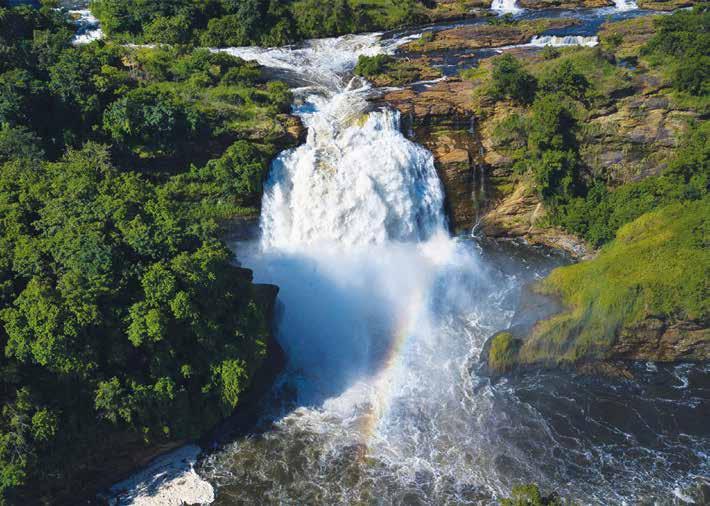
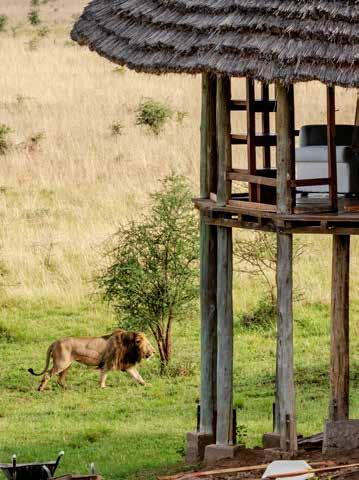
Clockwise from top:
At the Murchison Falls, the full might of the River Nile injects itself through an eight-metre-wide chasm to explode into the ominously named Devil’s Cauldron. An adult lion strolls by a lodge in Kidepo Valley National Park, whose stunning views can be seen below from Apoka Lodge, and left from a kopje.

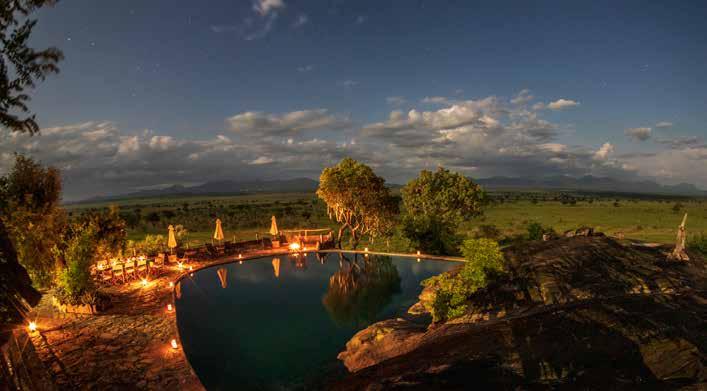
wherever I looked. “There are an estimated thirteen thousand buffalo in the park, but the herd we’re looking at here probably adds up to only about four thousand,” Phillip told me.
From Uganda’s far southeastern corner (touching Rwanda and Congo), I crossed the equator and travelled to the country’s far northwest tip, and the frontier lands of Kenya and South Sudan. In an article I wrote last year for CNN – a roundup of eight of the ‘best safari destinations in Africa’ – I stated that this Ugandan gem might be the most beautiful park on the entire continent. That afternoon as I watched the ever-changing light playing across the acacia-peppered savannah and across the flanks of sacred Mount Morungole, I was pleased to see that I hadn’t exaggerated Kidepo’s majesty.






How to Visit Kidepo National Park
Great Lakes Safaris (www. greatlakessafaris. com) offers a 4-night Kidepo Safari by road from $2390 pp sharing including accommodation, daily game drives, nature walk and a visit to the Karamojong community – expect a 10-11 hour drive from Entebbe International Airport.
Where to Stay
Apoka Safari Lodge (www.wildplacesafrica. com) – the finest accommodation option in Northern Uganda – offers wonderfully situated chalets overlooking the valley from $471 pp (based on 2 sharing), including all meals, house drinks, park fees, game drives and walks. Locally based Buffalo Safari Camps (www.buffalosafaricamps.com) run a 7-Day Murchison Falls and Kidepo Valley tour with 4x4 vehicles from $950 per person.
Kidepo’s Safari Highlights
Kidepo Valley National Park is home to 500 bird species and 86 mammals, 28 of which can be found nowhere else in Uganda, including caracal, lesser kudu, mountain reedbuck and Guenther’s dik-dik. Along with the largest population of buffalo of any park in Africa, there are an estimated 700 elephants and about 120 lions. CONTACT US: Website: www.ura.go.ug Email: services@ura.go.ug Call center/ Customer care: 0800 217 000, 0800 117 000
Follow us:
















